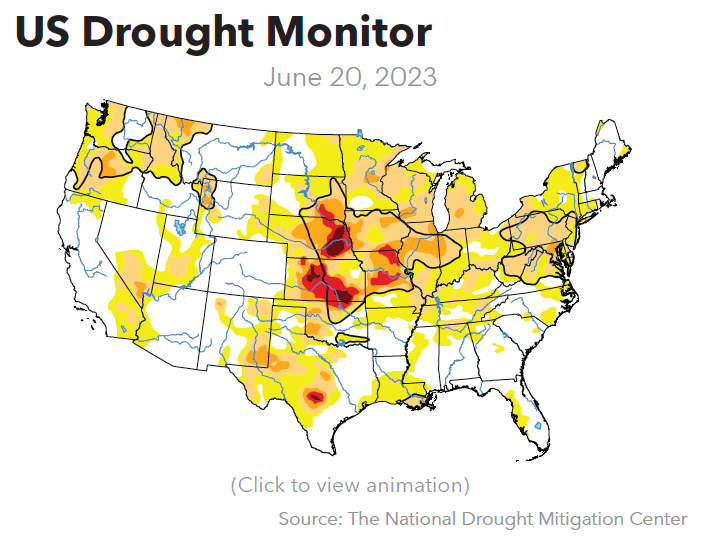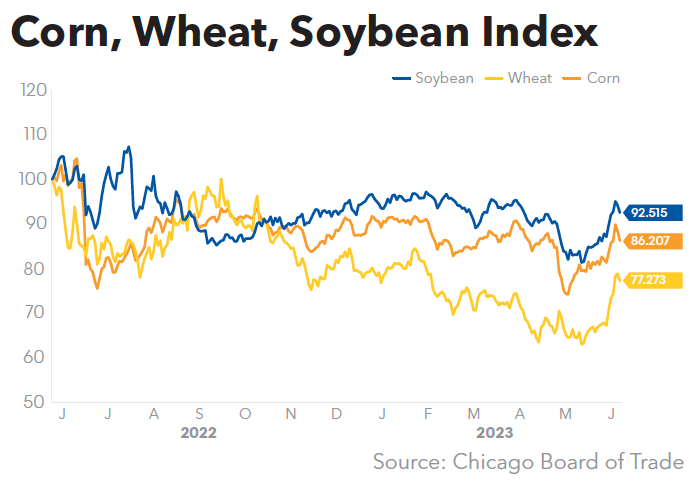Eastern Cornbelt:
Expanding drought conditions were a source of growing concern in the Eastern Cornbelt in mid-June. Most of Illinois is now in the moderate-to-severe drought category, according to the June 22 US Drought Monitor, with those same conditions reported across the northern half of Indiana.
Moderate drought also covered northwestern Ohio and the southern edge of the state at mid-month, with most of Michigan’s Lower Peninsula labeled as a moderate drought area as well.
The drought impact was taking a toll on crop quality at mid-month. Good or excellent ratings were assigned to just 36% of the Illinois corn crop on June 18, compared with 56% in Indiana, 61% in Ohio, and 32% in Michigan. Soybeans were also suffering, with just 23% of Michigan’s crop rated as good or excellent, compared with 33% in Illinois, 57% in Indiana, and 61% in Ohio.
Western Cornbelt:
Highs in the low-90s were common across central Iowa and Missouri at midweek, but forecasts warned of potentially severe thunderstorms by the coming weekend. Nebraska was also bracing for an active weather pattern as the week progressed, with thunderstorms, damaging winds, hail, and isolated tornadoes possible for western, central, and eastern areas of the state.
The entire Western Cornbelt was enveloped in worsening drought conditions, according to the June 22 US Drought Monitor. A broad band of extreme-to-exceptional drought covered eastern Nebraska and the western edge of Iowa, with severe-to-extreme drought blanketing most of northern Missouri.
Crop quality remained largely favorable in the region at mid-month, with good or excellent ratings assigned to 59% of the corn in Iowa and Nebraska, and 43% in Missouri. Good or excellent ratings were also assigned to 56% of Iowa’s soybeans, compared with 50% in Nebraska and 44% in Missouri, while Missouri’s cotton and rice crops were 60-65% good or excellent as of June 18.
Northern Plains:
Highs in the low-80s were common across the Dakotas during the week, with an increased chance of rain and thunderstorms by the weekend. Temperatures in the 90s were reported across southern Minnesota, but weekend rains were also in the forecast for much of the state.
Minnesota needs the moisture, as nearly all of the state is in some form of drought, ranging from abnormally dry in northern locations to pockets of severe drought in the east-central areas of the state. Eastern South Dakota was also experiencing moderate-to-extreme drought conditions as of June 22.
With corn now 91-99% emerged in the region, good or excellent ratings were assigned on June 18 to 67% of the acreage in Minnesota, 63% in North Dakota, and 48% in South Dakota. Soybean conditions were similar, with 67% of Minnesota’s crop rated as good or excellent, compared with 53% in North Dakota and 50% in South Dakota.
Minnesota led the region in small grains quality, with 58-67% of the spring wheat, barley, and oats rated as good or excellent in the state, compared with 50-56% in North Dakota and 32-40% in South Dakota.
Northeast:
The week started with cool, rainy conditions across New England, but highs in the mid-80s were expected by the end of the week. Pennsylvania, by contrast, was bracing for rain after a lengthy stretch of dry weather, with overnight lows dropping to the 50s and the possibility of coastal flooding as the week progressed.
With 83% of the crop emerged, Pennsylvania’s corn crop was rated at 38% good or excellent on June 18, with sidedress applications “going full tilt right now,” according to one contact.
“We got around two inches of rain, which was needed badly,” he added. “The rain inspired some more optimism and brought fertilizer demand back. So yes, crops are looking better than they did two weeks ago.”
Eastern Canada:
The week brought hot, humid weather to much of Eastern Canada, with Toronto temperatures reaching 26 C and humidex values hitting 31 C at midweek. Environment Canada issued a heat warning for parts of northern New Brunswick, with temperatures expected to climb to 30-32 C as the week progressed.
The hot, dry weather did little to help firefighting efforts in Quebec, where 88 active forest fires were burning early in the week. A stronger chance of rain was in the weekend forecast for much of the region, however.
Corn sidedressing was finishing up across the region in late June, sources said, along with some replanting of soybeans that suffered from dry weather earlier in the season. While some fertilizer prices were starting to reset for the summer, other suppliers were still out with spring price lists as demand starts to wind down in the region.

